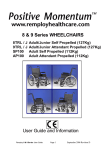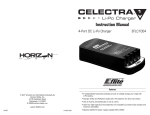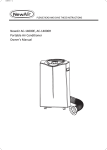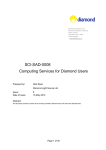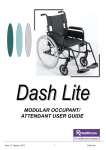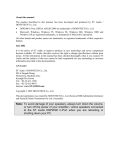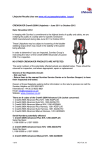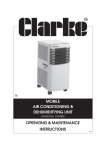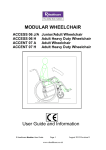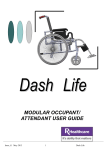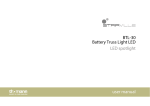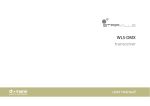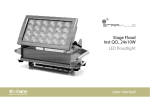Download Avanti CHAIR User's Manual
Transcript
REMPLOY HEALTHCARE AVANTI USER GUIDE & INFORMATION 05. 03 AVANTI CHAIR Page 1 March 2005 Revision B AVANTI USER GUIDE & INFORMATION THIS INFORMATION IS APPLICABLE TO THE AVANTI CHAIR IT SHOULD BE READ BY CARERS AND OTHER USERS WITH ALL OTHER INFORMATION SUPPLIED BEFORE ANYONE ATTEMPTS TO USE THE CHAIR WITH AN OCCUPANT THE PURPOSE OF THIS CHAIR IS TO PROVIDE A MEANS OF SAFE AND CONVENIENT HANDLING OF AN OCCUPANT WITH WALKING DIFFICULTIES, WHERE A CONVENTIONAL WHEELCHAIR IS NOT PRACTICAL BECAUSE OF SPACE OR TIME LIMITATIONS. IT IS NOT INTENDED FOR LONG TERM SITTING OR FOR OCCUPANTS WITH A SPINAL CONDITION Thank you for choosing a Remploy AVANTI CHAIR. We hope you will find it suitable for your needs. It will give you many years of trouble free use, if used according to the instructions. The Avanti is one of the many quality products supplied by Remploy. It is a one-size lightweight folding chair with convenient handling features, which can allow an attendant to quickly manoeuvre an occupant from one location to another, where space is limited, without the need for heavy lifting, or component assembly. It has front castors and rear fixed wheels. The armrests swivel for side accessibility. The User Guide contains essential information that must be read before attempting to use. Users requiring more detailed advice about using the chair should contact their Approved Distributor who has full service information manual and facilities. Remploy Healthcare Customer Services Dept. can supply additional product information. Avanti Chair User Guide Index Page 2 March 2005 Revision B 1.1 1.2 1.3 1.4 1.5 1.6 1.7 1.8 1.9 1.10 1.11 1.12 1.13 1.14 1.15 Introduction & Opening The Product Package Preparing The Chair For Use Side Access And Occupant Transfer Footrests Brakes Wheels Manoeuvrability And Safety 1.7.1 Going Down A Kerb 1.7.2 Going Up A Kerb First Method 1.7.3 Going Up A Kerb Second Method 1.7.4 Going Down / Up A Flight Of Steps Transportation Fire Precautions Cleaning And Maintenance Routines For Users User Safety Reference Checklist Warranty Service By Authorised Distributor Distributor Service Check List Avanti Chair Measured Data and advised info. Page 3 Page 4 Page 4 Page 6 Page 7 Page 7 Page 8 Page 8 Page 8 Page 9 Page 9 Page 9 Page 10 Page 10 Page 11 Page 12 Page 12 Page 13 page 13 Page 14 March 2005 Revision B 1.1 INTRODUCTION & OPENING THE PRODUCT PACKAGE For protection during transit the Avanti is packed in a cardboard carton, together with Guidance Information. The chair is supplied fully assembled in the folded condition. A storage/carry bag is included. Each chair has its own specific identification code label at the back of the chair. This code together with other product information such as occupant weight limit should also be noted. Labelling on the product is permanent, to bring user attention to important safety requirements and should not be removed. All the information should be read and understood, then kept in a safe place, and available for reference. Users are responsible for ensuring that the product is used safely and correctly according to the information supplied. Service requirements will depend upon the degree of actual use. We recommend that a chair used frequently be checked over by an authorised service department every twelve months. Packaging should be disposed of carefully and safely after an initial period of use. 1.2 PREPARING THE CHAIR FOR USE: This section will familiarise you with the main parts of the chair, and take you through the routine operations required before the Handling Chair can be used. It is useful to practice these until you are confident that you can do them easily. Page 4 March 2005 Revision B The Avanti can be opened by the following sequence of operations. • Remove chair from packing using seat handle. • Lift push handle. • Lock backrest and push handle into position by pulling cable up and locating pins in hinge bracket. Take care when locking into position. Ensure that quarter turn latch pin locates in to the tube. • Pin located in locked position in hinge bracket. • Apply Brake. • Place footrest in forward position. • Place one armrest into bottom position. • User access chair via side. • Place remaining armrest into bottom position. • Engage lap strap. Quarter Turn Latch. The chair can be opened easily with practice. Do not put fingers inside the structure when it is being opened and locked out. OCCUPANT TO BE SUPERVISED AT ALL TIMES ENSURE THAT BACKREST LOCK IS FULLY ENGAGED BEFORE USING Page 5 March 2005 Revision B When folding the chair after use, place a foot on one of the tipping levers, and grip the push bar with both hands. Pull the push bar upwards and the front and back frames will fold together. Release the backrest lock using one hand to operate the pull cord, and allow the backrest to fold, pivoting it slowly downwards, against the lower frames. For ease of handling, a carry bag is provided for the folded chair. Do not place heavy objects on the folded chair. 1.3 SIDE ACCESS AND OCCUPANT TRANSFER Preparation is important, if assistance is required it should be planned and available before attempting to use the Avanti with the intended occupant. The Avanti is suitable for occupant weights of up to 90 Kg. Direct lifting of the occupant should be avoided. The occupant requirements should first be considered. Some practice with an able bodied person will be useful before actually attempting the operation with the intended occupant. Assistance should be sought when it is assessed that the intended occupant would have difficulty in standing and getting into position. Before occupying the chair, take care to ensure that the brakes are on. The seat belt should be unbuckled and the armrests swivelled upwards away from the seat so as not to restrict side access. An attendant should grip the push handle bar whilst the occupant is being located in the chair. The simplest way to transfer into the Handling chair is for the occupant to stand with the feet firmly on the ground and then lowered slowly with assistance slowly into the seat, initially facing sideways. Then, once seated, swivelled to face forwards, with the feet resting on the footrest frame. A range of different handling equipment is available to make this operation easier for all concerned. A hoist may be appropriate in many instances where the occupant cannot stand and be lowered. Sideways sliding access by the occupant may also be possible from a sitting chair into the Avanti. If there is a gap between the two seat surfaces, it may be necessary to use a transfer board. DO NOT ATTEMPT SIDE TRANSFER ON SLIPPERY OR UNEVEN FLOORS Once seated in the Avanti the lap strap should secure the occupant. These come as standard equipment on the Avanti. They have tensioning adjustment and a quick release buckle. Use of a strap gives confidence to both occupant and attendant when the chair is being manoeuvred. When using the Avanti outdoors at night, ensure that chair occupant and attendant are visible, preferably carry out all transfers in a well lit area. Consider wearing light reflective clothing. Page 6 March 2005 Revision B 1.4 FOOTRESTS: The footrest is a simple frame which swivels and folds for storage. When in use the footrest should be pivoted to the outward locked position. Footrest height is not adjustable. Diagram shows footrest in outward locked position. 1.5 BRAKES: The toggle action parking brakes are located in pre set positions to act on the rear wheels. The brakes are intended to prevent the chair moving whilst the occupant is getting in or out of the chair. See service checklist also. The brake should be released when the chair is stored. Page 7 March 2005 Revision B 1.6 WHEELS All the wheels on the Avanti have puncture free polyurethane tyres. They are fitted with sealed roller bearings for life, and reliability, and should not need lubrication by the user under normal conditions. However care should be taken to avoid immersion of the wheels in water, or pressure washing, which can cause ingress into the moving parts, and result in deterioration of the wheel bearings. The puncture free tyres are maintenance free and hardwearing. If however a tyre becomes damaged, the wheel should be replaced. 1.7 MANOEUVRABILITY & SAFETY The chair should not be parked with the occupant sitting in it. THE OCCUPANT SHOULD NOT BE LEFT UNNATTENDED When manoeuvring, the occupant should always be secured by means of the lap strap provided. When pushing, the grip on the handle should be firmly grasped by the attendant. The attendant pushing the chair should walk at a sensible speed, and tell the occupant before changing position, tipping the chair or manoeuvring, also paying attention to the surface conditions and avoiding uneven or soft ground wherever possible. Shopping bags or other additional heavy loads should not be carried in the chair. Manoeuvrability in very tight areas will be easier, requiring less force, when the chair and occupant are tipped to balance on the rear wheels This is applicable particularly when negotiating kerbs. It is most important that carers understand the best techniques for descending steps or kerbs. Kerbs are a frequent manoeuvre, eg in transferring an occupant to and from a car, and can result in occupant discomfort if the attendant manoeuvring the chair is careless, and hurried. 1.7.1 Going down a kerb: The chair castors should be taken to the edge of the kerb. The attendant pushing should hold the chair handles firmly, pressing down on the tipping lever and at the same time tilting the chair back. The rear wheels can then be taken to the kerb edge and the foot removed from the tipping lever. The chair is then lowered down the kerb on its rear wheels, with the castor wheels facing rearwards, this prevents them jamming up momentarily as the chair starts to move, before pivoting the chair gently to the ground, to face direction of travel and then pushing forward. Page 8 March 2005 Revision B 1.7.2 Going up a kerb. (First Method) The chair footrest, or occupant feet if longer, should be taken to just in front of the kerb edge. The attendant pushing should grip the chair push bar firmly, pressing down on the tipping lever, tilting the chair backwards using body weight leverage, bringing chair forward till the back wheels touch the kerb. The front castors wheels can then be lowered down onto the path, making sure that the wheels are facing rearwards. With the push handles held firmly the attendant should now lift and push the chair. 1.7.3 Going up a kerb (Second Method) The chair should be turned round so that the back wheels are against the kerb and the attendant should hold the pushing handles firmly and tip the chair backwards. Using body weight as leverage the attendant should then pull the chair off the kerb and up onto the pavement, making sure, as above that the castor wheels are facing rearwards . The chair may then be pivoted to face the direction of travel and pushed forward. 1.7.4 Going down/up a flight of steps. Where possible, the hazard of negotiating steps should be avoided. Modern public buildings should provide permanent wheelchair ramps, with a practical slope angle for safe access, loose ramps pushed against a kerb are not recommended. Learning the geography of an area is important. A little journey planning can eliminate difficult manoeuvres. Many falls and injuries to both occupant and helper can occur when inexperienced people are carrying out this operation. Two attendants at least are required for step operation as shown typically above. The attendant supporting the main load should grip the chair at the push handles, and repeat the procedure for getting down a kerb at each step, the second attendant at the front will be required to guiding the footrest area, and provide reassurance to the occupant. A third person could act as guide for the chair team if the steps are high. Reverse this procedure for going up a flight of steps, with the attendant supporting the main load at the push handles pulling, and the second attendant at the front pushing the chair by gripping the corner of each side frame. Page 9 March 2005 Revision B 1.8 TRANSPORTATION THE AVANTI IS INTENDED FOR SHORT TERM OCCUPATION UNDER NO CIRCUMSTANCES SHOULD IT BE USED AS A VEHICLE SEAT Avanti occupants must transfer to a vehicle seat during a road or any other journey, with the chair securely stored separately in a purpose made storage area, available at the end of the journey for onward transfers. The folded Avanti weighs less than 8Kg, so it is convenient for lifting. The folded chair should be stowed safely in a position where it cannot become detached or damaged during a journey. Bear in mind that the temperatures reached in a hatchback car on a hot day can cause stored wheelchair component parts to become too hot to handle. 1.9 FIRE PRECAUTIONS DISABLED PERSONS ARE AT GREATER RISK THAN OTHERS. ENVIRONMENTS INTENDED FOR USE BY DISABLED PEOPLE SHOULD INCORPORATE APPROPRIATE SAFETY PRECAUTIONS When using any chair, both indoors and outside, always take precautions against fire risks. Avoid smoking, and do not use a chair near an open fire, or intense heat source. The Avanti is not specifically intended to be used as an emergency evacuation chair, but it can function in this way. In such applications, users must be familiar with the operation of the chair, in addition to the location of suitable fire exits and the necessary evacuation procedures. Page 10 March 2005 Revision B 1.10 CLEANING AND MAINTENANCE ROUTINES FOR USERS The Remploy Avanti is attractively finished, using high quality materials. It will retain its appearance during use if looked after and cleaned by the carer, or other responsible member of the family. Best results will be obtained if the paintwork is protected, using a car wax polish. Upholstery should be wiped with a damp cloth. Marks can be removed using a mild detergent. The Avanti is designed for the minimum, amount of service maintenance. However, we recommend that users inspect the chair regularly and look particularly at the following: Locking Catches: Check that the backrest lock pins operate smoothly when the cable is pulled, and latch easily into position to retain the backrest. Brake: Check that the parking brake is operating correctly. Pivots: Occasional light lubrication of the pivots will improve opening and closing. Upholstery cleaning The fabric used for wheelchair upholstery is easily cleaned in-situ. However, as there are some substances which may affect the material, careful attention to REGULAR cleaning will not only prolong its life but will ensure that its appearance is maintained. Resistance to stains and chemicals The upholstery is resistant to most mild acids, alkalis and household stains. Some substances such as ballpoint pen ink, lipstick, newsprint and food colourings may be absorbed by the vinyl and cause permanent staining. This can often be minimised by immediate cleaning with a damp, soapy cloth or sponge To maintain its appearance, the fabric should be cleaned REGULARLY to remove fatty substances in soiling, which may reduce its service life. Light soiling can be removed by adding a small amount of washing up liquid to some warm water and then applying to the fabric with a cloth. Rinse off with clean water before allowing to dry. If need be, a Mild solution of antiseptic can be applied to the fabric. Do not use Chemical bleaching materials, abrasive cleaners, wax polishes or aerosol spray polishes on the upholstery. The use of these substances is likely to be harmful to PVC laminates and repeated use can result in the removal of plasticiser from the PVC compound which will result in hardening and subsequent cracking of the material’s surface. Page 11 March 2005 Revision B 1.11 USER SAFETY REFERENCE CHECKLIST The Avanti is intended to provide short-term mobility for occupants weighing up to 90kg. It should not be used for occupants with spinal conditions. It should be used exclusively for this purpose. Any other form of use will be regarded as misuse and neither manufacturer nor supplier will be responsible for any injury or damages sustained. Please ensure that the operation of this product is fully understood before using. • Ensure that backrest lock is fully engaged before using. • Ensure that parking brake is applied when occupant is transferring. • Ensure that all parts of occupant body or clothing are clear of any moving parts of the chair. • Do not leave the occupant unattended in the chair. • Do not exceed the weight limit of 90kg. • Do not carry more than one occupant in the chair. • Do not carry shopping bags or other items in the chair. • Do not try to fold or unfold any part of the chair. Apart from the swivelling armrests, when the occupant is sitting in it. • Do not propel the chair at speeds in excess of normal walking pace. Take care going down kerbs. • Do not be use for racing or sports, or any situation where excessive speeds may be encountered. 1.12 WARRANTY Remploy Healthcare guarantees the products supplied to be free from manufacturing defects, and will replace components where necessary free of charge, for a period of 24 months from the date of purchase. This guarantee is subject to the condition that the product has been used, adjusted and maintained in accordance with user and maintenance instructions supplied by Remploy Healthcare. Warranty can be affected if a chair is not adequately maintained UNAUTHORISED CHAIR MODIFICATIONS MAKE THIS WARRANTY VOID. REMPLOY ARE NOT RESPONSIBLE FOR ANY ACCIDENT RESULTING FROM SUCH UNAUTHORISED MODIFICATIONS. This does not affect statutory rights. A more complete warranty statement is available on request from Authorised Distributor or Disablement Service Centre. Page 12 March 2005 Revision B 1.13 SERVICE BY AUTHORISED DISTRIBUTOR Service Records should be completed by the Authorised Distributor Servicing Department and retained by the user as a reference. The Authorised Distributor should carry out Service checks at the recommended interval specified on the Service Record. We recommend that the distributor check chairs at assessed intervals, according to the level of use and usage environment. A Handling chair used frequently should be serviced annually. Batch code and serial numbers are essential for the specification of spare parts. If in doubt, your Authorised Dealer or Rehabilitation Specialist will be able to provide help and professional advice on correct and safe use of wheelchairs. All Remploy products are designed with the needs of disabled people in mind. We hope that our products provide their users with the freedom and independence they need for a more active and improved lifestyle. Remploy Healthcare Group has a policy of constant product improvement and reserves the right to change specifications without prior notice. 1.14 DISTRIBUTOR SERVICE CHECK LIST Brakes The brake should hold the chair on a ramp angle of approx. 10 degrees. Wheels Check general condition, free running and clearance in hubs, wheel wobble of 3mm measured at rim is acceptable, excessive movement is an indication of wear. Chairs with damaged tyres will require wheel replacement. Moving Parts Occasional lubrication of sliding parts and pivots. We recommend the use of a non-toxic lubricant be used. eg Superlube Plus (from Lubrication Services) which is FDA approved for food use, will allow easy operation. Upholstery and trim The upholstery should be wiped with a damp cloth. Marks can be removed using a mild detergent. Washing of the complete chair may be carried out by a in a purpose built machine. Pressure washing is not recommended. Minor upholstery damage should be repaired before it causes problems. A slight catch in the upholstery may result in a longer tear if not dealt with when it first occurs. Torn and damaged upholstery and handgrips should be replaced. Frame and Check for strain and misalignment. Check for security of fasteners. Fittings Paintwork damage should be touched up, and generally protected using a proprietary car wax polish. Check that all detachable parts latch in correctly and positively, particularly backrest lock, footrests and armrests. Page 13 March 2005 Revision B 1.15 Avanti Wheelchair Measured Data And Advised Information. Positive Momentum OVERALL DIMENSIONS AVANTI OCCUPANT WEIGHT RANGE 50Kg TO 90Kg KG SEATING AREA DIMENSIONS WHEEL BASE CASTORS TRAILING FOOTREST INFORMATION REAR WHEEL INFORMATION ARMREST INFORMATION CASTOR INFORMATION FRAME / SEAT ANGLE INFORMATION WEIGHT INFORMATION K KG OBSTACLES AND ENVRIONMENTS CORRIDOR WIDTH TURNING SPACE INCLUDES ATTENDANT ISO 7176 IMPACT STRENGTH & DYNAMIC TESTS Page 14 March 2005 Revision B














